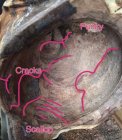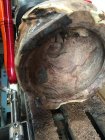-
December 2025 Turning Challenge: Single Tree! (click here for details) -
Congratulations to Bob Henrickson, People's Choice in the November 2025 Turning Challenge (click here for details) -
Congratulations to Steven Gordon for "Dropped Ice Cream Cone" being selected as Turning of the Week for December 8, 2025 (click here for details) -
Welcome new registering member. Your username must be your real First and Last name (for example: John Doe). "Screen names" and "handles" are not allowed and your registration will be deleted if you don't use your real name. Also, do not use all caps nor all lower case.
You are using an out of date browser. It may not display this or other websites correctly.
You should upgrade or use an alternative browser.
You should upgrade or use an alternative browser.
Mesquite burl problem
- Thread starter Dick Sutherland
- Start date
- Joined
- Jan 27, 2005
- Messages
- 13,177
- Likes
- 5,752
- Location
- Dalworthington Gardens, TX
- Website
- pbase.com
Welcome aboard, Dick.
I see a lot of tear out and tool bounce. That is usually an indication of one or more of the following:
Looking at the full size image I see what appears to be several significant cracks in the wood between the 7 and 9 o'clock positions with one that appears to go from the rim to the center as well as several other small cracks and ring shake (cracks separating growth rings. There also seems to be some cracks around the bark inclusion. It looks like the wood has some punky areas between 2 and 4 o'clock. I would also like to see the tenon to make sure that it isn't bottoming out in the chuck and that it has a good crisp shoulder so that the piece isn't rocking in the chuck.

Dry mesquite usually turns well, but like other species of wood it might possibly have crystallized mineral deposits that can rapidly dull the sharpest of tools including carbide. I once turned a tool handle from GREEN black walnut that had so much mineral deposits that I wore out several carbide cutters.
I see a lot of tear out and tool bounce. That is usually an indication of one or more of the following:
- too much tool overhang on the rest
- cutting below centerline
- thin wall thickness
- using dull tool
- Too much tool pressure
Looking at the full size image I see what appears to be several significant cracks in the wood between the 7 and 9 o'clock positions with one that appears to go from the rim to the center as well as several other small cracks and ring shake (cracks separating growth rings. There also seems to be some cracks around the bark inclusion. It looks like the wood has some punky areas between 2 and 4 o'clock. I would also like to see the tenon to make sure that it isn't bottoming out in the chuck and that it has a good crisp shoulder so that the piece isn't rocking in the chuck.

Dry mesquite usually turns well, but like other species of wood it might possibly have crystallized mineral deposits that can rapidly dull the sharpest of tools including carbide. I once turned a tool handle from GREEN black walnut that had so much mineral deposits that I wore out several carbide cutters.
I've found mesquite easy to turn, but have only turned a couple of pieces. Some of your bounce is likely coming from that punky section, to solid wood, then to resin. While also turning through splits and cracks. Have you tried a bowl gouge? I wouldn't do too much internal work until you get the outside finished. You'll then have trouble with chatter trying to true up the outside with thinner walls if you continue to proceed as you are. Also, what tools you are using aren't even cutting the resin cleanly. I suggest you spend some time sharpening.
Post a photo of the lathe tool on the tool rest with the lathe tool in contact with the wood blank, this will provide a better idea on a solution. Sometimes a scraper or roughing gouge presented at the proper angle with very little overhang will cut through hard wood, you should try to get the outer side roughed out to get the blank balanced, once you get the piece balanced out it will be easier to make smoother cuts. Some hard woods require repeated trips to the grinder to present a sharp blade to the hard wood to cut it cleanly. Once the blade dulls it stops cutting and increases the vibration, bouncing and catches. .
That grey area at around 7-8 oclock looks like a rock embedded in the wood. It only takes a few revolutions of hitting that and any tool, carbide or hss, will be dull. If that is a rock, dig it out, resharpen, and keep a close lookout for any more. If it's not a rock, I'm curious as to what it is.
- Joined
- Jan 27, 2005
- Messages
- 13,177
- Likes
- 5,752
- Location
- Dalworthington Gardens, TX
- Website
- pbase.com
That grey area at around 7-8 oclock looks like a rock embedded in the wood. It only takes a few revolutions of hitting that and any tool, carbide or hss, will be dull. If that is a rock, dig it out, resharpen, and keep a close lookout for any more. If it's not a rock, I'm curious as to what it is.
@Curtis Fuller I think it's the same resin as you see between 10 and 11 o'clock. I just noticed that the other tools in the picture besides the Sorby hollowing scraper are Easy Wood Tools carbide scrapers. I have a couple EWT carbide scrapers and I'm not very impressed, They start out sorta' sharp and go downhill much faster than I would expect from a carbide tool ... certainly much faster than Hunter or Rolly Munro carbide cutters.
Now that I know EWT scrapers were used, it seems more evident that the problems are from dull edges along with large overhang leading to chatter. If the wood also has cracks that could make things unsafe.
- Joined
- Apr 27, 2004
- Messages
- 9,304
- Likes
- 6,058
- Location
- Lakeland, Florida
- Website
- www.hockenberywoodturning.com
I too am Curious about the feature at 7-8 o’clock that @Curtis Fuller asked about. Resin as @Bill Boehme suggests?
Good advice above,
With dry wood you have to adjust the feed rate of the tool.
Sharp tools, lighter cuts.
With punky wood a misting with water often stiffens the fibers enough to get a clean cut.
Thin shellac or thin lacquer will stiffen the fibers more.
I would use a gouge on that piece and I would turn the outside first as well.
Good advice above,
With dry wood you have to adjust the feed rate of the tool.
Sharp tools, lighter cuts.
With punky wood a misting with water often stiffens the fibers enough to get a clean cut.
Thin shellac or thin lacquer will stiffen the fibers more.
I would use a gouge on that piece and I would turn the outside first as well.
Ahhhh, Mesquite---don't you just love the variability in the wood? My favorite to turn.
Great advice on the tools, especially the carbides---started out with those, but don't use so much anymore.
Look at the cracks, if there's matrix from the tree in them--usually appears as a dark line which shows the tree was repairing them, ie--no gaps between edges. Those I watch and turn not real fast. if the cracks have narrow gaps---well, that's what CA was made for. Large gaps I will fill with epoxy as I'm turning, looking to see if they extend any farther, and look them over for extension whenever I stop the lathe--- or if the "sound" changes while turning.
The dark area is most likely the inside of a bark inclusion---there is NO mistake about missing a rock being there.
As for the punky area (which are common in burly pieces), I like to use thin CA. It'll require reapplications.
Sometimes history helps---I won't turn Mesquite that's been 'dozed--those cracks you don't see until it explodes (been there done that)---you just don't see them.
If it's too much---could send it here for "inspection"
Great advice on the tools, especially the carbides---started out with those, but don't use so much anymore.
Look at the cracks, if there's matrix from the tree in them--usually appears as a dark line which shows the tree was repairing them, ie--no gaps between edges. Those I watch and turn not real fast. if the cracks have narrow gaps---well, that's what CA was made for. Large gaps I will fill with epoxy as I'm turning, looking to see if they extend any farther, and look them over for extension whenever I stop the lathe--- or if the "sound" changes while turning.
The dark area is most likely the inside of a bark inclusion---there is NO mistake about missing a rock being there.
As for the punky area (which are common in burly pieces), I like to use thin CA. It'll require reapplications.
Sometimes history helps---I won't turn Mesquite that's been 'dozed--those cracks you don't see until it explodes (been there done that)---you just don't see them.
If it's too much---could send it here for "inspection"

